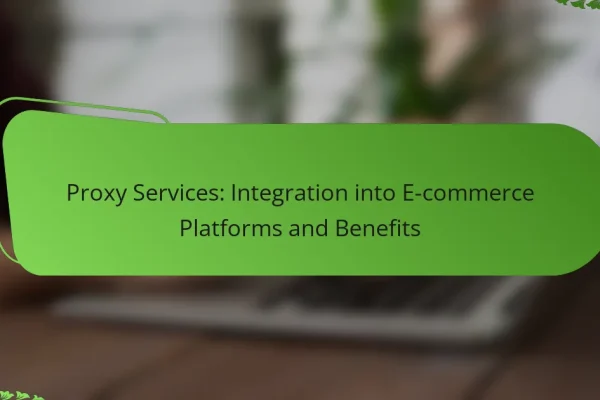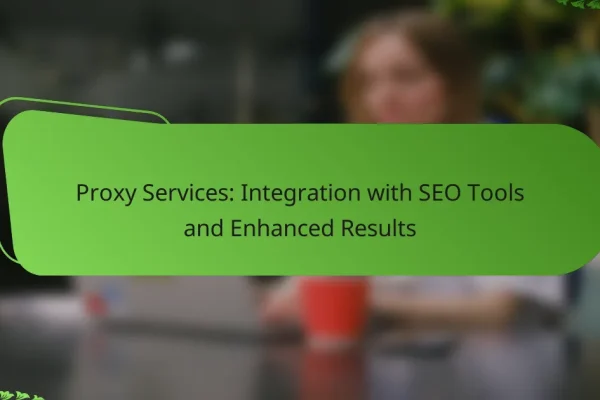How do proxy services integrate with SaaS tools?
Proxy services integrate with SaaS tools by providing a layer of anonymity and security, enabling users to access and manage data without revealing their IP addresses. This integration enhances performance, data collection, and compliance with regulations while ensuring that sensitive information remains protected.
Integration with web scraping tools
Proxy services are essential for web scraping tools as they allow users to collect data from websites without being blocked. By rotating IP addresses, proxies help maintain access to target sites, especially those with strict anti-scraping measures. Users should consider using residential proxies for better success rates, as they appear as regular users to the websites being scraped.
When integrating proxies with scraping tools, it’s important to monitor the speed and reliability of the proxy service. A good practice is to choose a provider that offers a range of IPs and supports simultaneous connections to maximize data extraction efficiency.
Integration with SEO tools
Proxy services enhance SEO tools by enabling users to perform keyword research, competitor analysis, and rank tracking without revealing their identity. This is particularly useful for businesses that want to analyze local search results or test their website’s performance from different geographic locations.
When using proxies with SEO tools, ensure that the proxies are optimized for speed and reliability. It’s advisable to select proxies that allow for geo-targeting, which can provide more accurate insights into local search engine performance.
Integration with data analytics platforms
Proxy services can significantly improve data analytics platforms by facilitating the collection of large datasets from various sources without the risk of IP bans. This capability allows businesses to gather comprehensive insights from competitors and market trends while maintaining data integrity.
For effective integration, choose a proxy provider that offers high bandwidth and low latency to ensure real-time data processing. Additionally, consider using dedicated proxies for sensitive data analytics tasks to enhance security and performance.
What are the benefits of integrating proxy services?
Integrating proxy services can significantly enhance online operations by improving data collection, ensuring anonymity, and enabling access to restricted content. These benefits make proxies essential tools for businesses and individuals seeking to optimize their internet usage.
Improved data collection
Proxy services facilitate more efficient data collection by allowing users to gather information from multiple sources without being blocked or restricted. This is particularly useful for market research, web scraping, and competitive analysis.
By rotating IP addresses, proxies can help avoid detection and throttling from target websites, leading to more accurate and comprehensive data sets. Businesses can leverage this capability to gain insights into consumer behavior and market trends.
Enhanced anonymity and security
Using proxy services enhances online anonymity by masking the user’s IP address, making it harder for third parties to track online activities. This is crucial for individuals concerned about privacy and security while browsing the internet.
Additionally, proxies can provide an extra layer of security by filtering out malicious content and protecting sensitive information. For example, businesses can use proxies to safeguard their networks from cyber threats while employees access the internet.
Bypassing geo-restrictions
Proxy services enable users to bypass geo-restrictions by routing internet traffic through servers located in different countries. This allows access to region-locked content, such as streaming services or websites that may be unavailable in certain areas.
For instance, a user in Europe can access US-based content by connecting to a proxy server in the United States. This capability is particularly valuable for travelers or expatriates wanting to access familiar services from their home countries.
Which proxy services are best for integration?
Several proxy services excel in integration capabilities, making them suitable for various applications. Bright Data, Smartproxy, and Oxylabs are among the top choices, each offering unique features that cater to different needs.
Bright Data
Bright Data, formerly known as Luminati, is renowned for its extensive proxy network and robust integration options. It provides a wide range of APIs that allow seamless integration with various tools and platforms, making it ideal for developers and businesses looking to automate tasks.
When considering Bright Data, evaluate its pricing model, which can be based on bandwidth or the number of IPs used. This flexibility can suit different project scales, from small startups to large enterprises.
Smartproxy
Smartproxy is another strong contender, offering a user-friendly interface and easy integration with popular tools. It supports various protocols, including HTTP and SOCKS5, which enhances compatibility with different applications.
Smartproxy’s pricing is competitive, with options for both pay-as-you-go and subscription plans. This makes it accessible for users who need reliable proxy services without a hefty upfront investment.
Oxylabs
Oxylabs stands out for its high-quality residential proxies and efficient integration capabilities. It provides detailed documentation and support, which can significantly ease the setup process for users integrating with their existing systems.
Consider Oxylabs if your projects require a large volume of data scraping or web crawling, as it offers a vast pool of IPs. However, be mindful of its pricing, which may be on the higher side compared to other services, reflecting its premium offerings.
What tools commonly integrate with proxy services?
Proxy services commonly integrate with various tools to enhance data collection, SEO analysis, and web analytics. These integrations allow users to bypass geographical restrictions, improve data scraping efficiency, and ensure accurate tracking of web traffic.
Scrapy
Scrapy is a powerful web scraping framework that can integrate with proxy services to manage requests and avoid IP bans. By routing requests through proxies, Scrapy can scrape data from websites more effectively, especially those with strict anti-scraping measures.
When using Scrapy with proxy services, it’s essential to configure the middleware settings properly. This includes setting up a rotating proxy to distribute requests across multiple IP addresses, which can significantly reduce the risk of being blocked.
Ahrefs
Ahrefs is a popular SEO tool that can benefit from proxy services by allowing users to gather data from various regions without being restricted by local IP addresses. This is particularly useful for keyword research and backlink analysis, where regional variations can impact results.
To effectively use Ahrefs with proxy services, consider using a dedicated proxy for each project. This approach helps maintain data integrity and ensures that the results reflect the specific geographic area being analyzed.
Google Analytics
Google Analytics can integrate with proxy services to manage and analyze web traffic data from different locations. This integration allows businesses to track user behavior and performance metrics without the limitations of geographical restrictions.
When implementing proxy services with Google Analytics, ensure that the tracking code is correctly configured to reflect the proxy’s IP address. This setup helps in accurately capturing data and understanding user interactions across various regions.
What are the prerequisites for integrating proxy services?
To successfully integrate proxy services, you need a clear understanding of your specific requirements, the tools involved, and the technical capabilities of the proxy service. Essential prerequisites include familiarity with API documentation, the right choice of proxy type, and a solid grasp of your network architecture.
Understanding API documentation
API documentation is crucial for integrating proxy services as it provides detailed instructions on how to interact with the proxy’s functionalities. Familiarize yourself with endpoints, request formats, authentication methods, and response structures to ensure seamless integration.
When reviewing API documentation, pay attention to rate limits, error handling, and any specific requirements for data formats. This knowledge will help you avoid common pitfalls and streamline the integration process.
Choosing the right proxy type
Selecting the appropriate proxy type is essential for meeting your integration needs. Common types include residential proxies, data center proxies, and mobile proxies, each with distinct advantages and use cases. For instance, residential proxies are often preferred for web scraping due to their legitimacy, while data center proxies are typically faster and more cost-effective.
Consider factors such as speed, reliability, and geographical coverage when choosing a proxy type. Evaluate your specific use case, whether it’s for data collection, anonymity, or bypassing geo-restrictions, to make an informed decision that aligns with your goals.
How to choose the right proxy for your tools?
Choosing the right proxy for your tools involves assessing your specific needs, including bandwidth, speed, and location coverage. Consider the type of tasks you will perform and the requirements of the tools you plan to integrate with the proxy service.
Assessing bandwidth and speed
When evaluating bandwidth and speed, determine the data transfer requirements of your applications. For instance, tasks like web scraping or streaming may require higher bandwidth, while simple browsing can function with lower speeds.
Look for proxies that offer speeds in the low tens of milliseconds for optimal performance. A good rule of thumb is to aim for a proxy that provides at least 1 Gbps bandwidth for demanding applications.
Evaluating location coverage
Location coverage is crucial for accessing region-specific content or services. Ensure the proxy provider has servers in the regions relevant to your needs, as this will affect both speed and accessibility.
For example, if you need to access European websites, choose a proxy with multiple servers across various European countries. This not only enhances speed but also helps in bypassing geo-restrictions effectively.












